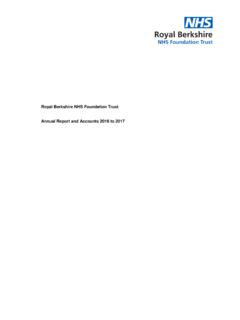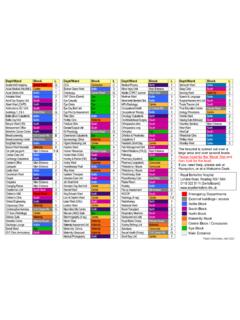Transcription of Possible effects of offering formula milk to a ...
1 offering formula milk to a breast feeding baby, June 2017 Page 1 of 3 Possible effects of offering formula milk to a breastfeeding baby This leaflet outlines information about effective feeding methods for your baby and aims to help you make an informed decision about which method to use. If you have any further questions, please ask your midwife. breastfeeding is usually the most natural and instinctive way to feed a newborn baby. It is generally recognised that exclusive breastfeeding is the most beneficial feeding method for both mother and baby in terms of health outcomes (NICE 2006). breastfeeding provides a complete food, and is actively protective for both mother and baby, whilst formula , although meeting with European nutritional standards (Commission Directive 2006), does not provide immunity or contain any of the other ingredients that breast milk does.
2 However, some mothers and babies find that feeding is challenging in the early days, especially after a difficult birth. Often parents feel very anxious about their baby s wellbeing and may request formula when their intention is to breastfeed. This leaflet provides some information to help you make an informed decision. Our staff will support you to understand your baby s behaviour, as some babies are reluctant and sleepy at first whilst others feed frequently. Staff will suggest ways of soothing your baby, support you to recognise effective feeding , and help you express your breast milk in the first instance.
3 Some things to consider: offering formula milk for your baby when your intention is to breastfeed may affect your supply as breastfeeding works best if you repeatedly put your baby to the breast again and again. This extra stimulation will improve your supply and help settle your baby. Your first milk (colostrum) is nourishing, rich in protective properties and is all your baby needs in the first few days before your milk comes in. By not offering the breast as frequently your breasts can become over-full (engorged), which is painful and means attaching your baby can become more challenging.
4 It can also lead to mastitis. Engorgement can be relieved by expressing milk using a pump or by hand. Maternity information offering formula milk to a breast feeding baby, June 2017 Page 2 of 3 Maternity information Sucking on a bottle teat may make it more difficult for the baby to latch to the breast effectively as the action the baby makes with its mouth when feeding from a teat is very different. Babies given large volumes of formula can be less satisfied on subsequent breastfeeds, which are naturally smaller in volume while delivering the exact nutrition baby needs. formula milk alters the bacterial environment in the baby s gut.
5 By not exclusively breastfeeding , your baby is more likely to develop infections such as gastro-enteritis, diarrhoea, and urine, ear and chest infections. Additionally, exposure to the cow s milk protein found in formula can cause intolerances. If there is a history of allergy in your family, giving formula may increase the risks of your baby developing hay fever, asthma and eczema. Helpful hints: Keep your baby near you and enjoy plenty of skin contact and talk to your baby, all of which will help soothe and calm you both. Hold your baby Kangaroo style directly next to your skin ensuring baby s mouth and nose are kept clear so baby can breathe easily and be observed by you.
6 Feed baby on early feeding cues (opening and closing mouth, sucking hands, turning head to side) and ring the call bell; our staff can help you to latch baby as inefficient attachment can lead to sore nipples and an unsatisfied baby. Feed lying down so you can rest. Try a laid back position which encourages your baby s instinctive behaviour to self-latch. Express small but frequent amounts and give this to your baby regularly on a finger or by syringe which will help to settle baby and stimulate a reluctant sleepy baby. Have a warm drink and talk to the staff about your concerns. Decisions: If you do decide to give formula after reading this leaflet and considering your options then the staff will be sensitive to your informed decision, and will support you to keep your options open to continue breastfeeding .
7 Suggestions: Offer the formula in small amounts to mimic how breastfeeding works. Use a cup where Possible (your baby will lap the milk like a cat) to avoid Possible teat confusion. Keep trying the baby on the breast . If nothing else, baby will enjoy the closeness. Maintain expressing so that all your options remain open. Things change rapidly and as babies grow difficulties with latch often disappear. offering formula milk to a breast feeding baby, June 2017 Page 3 of 3 Maternity information Continue with prolonged skin contact for as long as Possible as this stimulates your milk supply.
8 Seek support from the infant feeding team as appropriate. Further information and support breastfeeding clinic appointments 0118322 7295 open 10:00-13:00 Monday-Friday Level 2 Maternity Block RBH - (BfN) local 07501466818 or national 0300100 0210 - 0300 33 00 771 More information is available on the Trust website at: References 1. NICE (2006) postnatal guidance on feeding 2. NICE guidance on maternal and child nutrition see 3. The Commission of the European Communities. Commission directive 2006/141/EC of 22 December 2006 on infant formulae and follow-on formulae and amending Directive1999/21/EC.
9 Available from: :L:2006:401:0001:0033:EN:PDF This document can be made available in other languages and formats upon request. Written by: Claire Carter, Infant feeding Lead Midwife, May 2016 Revised: May 2017 Approved: Maternity information Group & Patient information Manager, June 2017 Review due: June 2019








